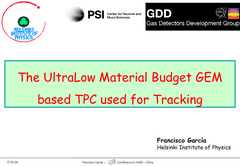The UltraLow Material Budget GEM based TPC used for Tracking
ID:99
View Protection:ATTENDEE
Updated Time:2024-10-17 01:38:25
Hits:490
Oral Presentation
Abstract
The GEM based Time projection Chamber in Twin configuration [1] used for tracking of particles has evolved during the last years. This detector has been mainly developed for the tracking of protons to Uranium for the Super-FRS at the FAIR facility [2]. The detector consists of two GEM-TPCs inside the same vessel. One GEM-TPC is rotated by 180 degrees with respect to the other one at the middle plane, such that the drift field of both GEM-TPCs are in opposite directions with the sensitive area perpendicular to the incoming particles. The readout geometry of each of the GEM-TPCs is a one-dimensional (1D) strip parallel to the incoming beam. This configuration is named Twin. The readout electronics used is the VMM3a based Scalable Readout System.
The main idea behind this configuration is the ability to increase the tracking efficiency at higher rates i.e. when the multiplicity of hits within the drift volume poses a challenge in their association to the corresponding track. This is achieved by using the Control Sum method.
The HGB4-2 detector, which stands for Helsinki-Bratislava-GSI generation four (4th) prototype two (2) has been tested in the H4 beamline of the SPS at CERN with muons and pions as primary particles. Using different gas mixtures like: Ar/CO2 (70/30), He/CO2 (90/10) and (70/30). During the latest campaigns, scans of the drift fields have been performed in order to quantify the combined effect of the drift velocity and the diffusion on its overall performance.
One of the last pending measurements for this detector was the spatial resolution and rate capability for protons in Minimum Ionizing Regime, therefore, to mimic such projectiles, pions were used. As result this prototype is now finalized, and suitable for mass-production for the Finnish in-kind contribution to FAIR. In addition, such concept exhibiting very good spatial resolution, lower than from the requirements.
References:
[1] F. Garcıa, et al, A GEM-TPC in twin configuration for the Super-FRS tracking of heavy ions at FAIR, Nuclear Instruments and Methods in Physics Research Section A: Accelerators, Spectrometers, Detectors and Associated Equipment, Volume 884, 2018, Pages 18-24, ISSN 0168-9002, https://doi.org/10.1016/j.nima.2017.11.088.
[2] Conceptual Design Report (CDR) and Baseline Technical Report (BTR) for FAIR at http://www.gsi.de/fair/reports/index.htmln
The GEM based Time projection Chamber in Twin configuration [1] used for tracking of particles has evolved during the last years. This detector has been mainly developed for the tracking of protons to Uranium for the Super-FRS at the FAIR facility [2]. The detector consists of two GEM-TPCs inside the same vessel. One GEM-TPC is rotated by 180 degrees with respect to the other one at the middle plane, such that the drift field of both GEM-TPCs are in opposite directions with the sensitive area perpendicular to the incoming particles. The readout geometry of each of the GEM-TPCs is a one-dimensional (1D) strip parallel to the incoming beam. This configuration is named Twin. The readout electronics used is the VMM3a based Scalable Readout System.
The main idea behind this configuration is the ability to increase the tracking efficiency at higher rates i.e. when the multiplicity of hits within the drift volume poses a challenge in their association to the corresponding track. This is achieved by using the Control Sum method.
The HGB4-2 detector, which stands for Helsinki-Bratislava-GSI generation four (4th) prototype two (2) has been tested in the H4 beamline of the SPS at CERN with muons and pions as primary particles. Using different gas mixtures like: Ar/CO2 (70/30), He/CO2 (90/10) and (70/30). During the latest campaigns, scans of the drift fields have been performed in order to quantify the combined effect of the drift velocity and the diffusion on its overall performance.
One of the last pending measurements for this detector was the spatial resolution and rate capability for protons in Minimum Ionizing Regime, therefore, to mimic such projectiles, pions were used. As result this prototype is now finalized, and suitable for mass-production for the Finnish in-kind contribution to FAIR. In addition, such concept exhibiting very good spatial resolution, lower than from the requirements.
References:
[1] F. Garcıa, et al, A GEM-TPC in twin configuration for the Super-FRS tracking of heavy ions at FAIR, Nuclear Instruments and Methods in Physics Research Section A: Accelerators, Spectrometers, Detectors and Associated Equipment, Volume 884, 2018, Pages 18-24, ISSN 0168-9002, https://doi.org/10.1016/j.nima.2017.11.088.
[2] Conceptual Design Report (CDR) and Baseline Technical Report (BTR) for FAIR at http://www.gsi.de/fair/reports/index.htmln




Comment submit